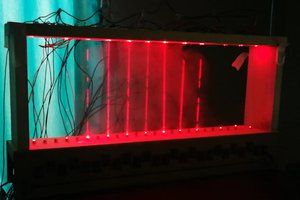Second in a series of laser experiments
To make the experience fit your profile, pick a username and tell us what interests you.
We found and based on your interests.
In this experiment I am testing the 808nm laser diodes. There will be 100 of these 3 watt modules wrapped around my yag rod.
November 30
My laser goggles arrived a couple of days ago. These cover the wave length range of the yag output.
The Paraboilc Mirror;
This is a excelent calulator for parabolic formulas.
https://www.desmos.com/calculator
I was able to create the profile and the focus point of my desired Parabolic Mirror.
I then cut 20 of these poly curves on my cnc cutter. The 20 profiles were then assembled into this block and held fast by a 3/8 x 5 " bolt.
I Cut a peice of 6" copper pipe and hammered it over the form this took a long tiime and I used my bender, clamps and sledge hammer to form the copper very close to the profile.
The curve was smoothed and 80 grit sand paper was attached to the block.
The sanding block was clamped into a bench vice. The first sanding took only 7 hours. Dedication to a single task. I used water and oil to assist the honing. Next 240 grit 4 hours of sanding.Then 600 grit. 4 hours. Finally 1200 grit and a polishing paste 12 hours.
The mirror will be nickel plated then gold for ~ 90% reflective surface.
Brass end plates were then machined on the cnc, and the yag mount hole were cut.
This is one of the led modules I am using.
I have modified it to remove the ears and the corner tabs.
I will be using the connection inside the module.
Here the 9 modules are mounted on the heatsink. I used 1" stainless No. 4X40 the extra length will assist in the cooling. This whole unit will sit in an enclosure that will be water cooled.
I have place the mirror on the top of the led bank to show the alignment.
Create an account to leave a comment. Already have an account? Log In.
Where is the detaield schematic, inclusive of board component/configuration?
I need to get the test results from my yag laser experiments.
I will answer these questions with actual lab tests
1. What is the actual output of the crystal when pumped with all kinds of led sources.
2. What is the efficiency of the conversion.
The white LED modules don't produce any wavelengths within the absorption band of the Nd+3 ion in YAG. You could have 50000 Watts of power worth of white LEDs, and it still won't lase. It is possible to pump with LED's, but the wavelength must be correct, and the emission bandwidth of LED's is quite broad compared to a laser diode, so most of the optical power is wasted, and emission threshold is very difficult to achieve. It would be far less expensive, and more compact, to buy a used 20W or higher power 808nm laser bar off ebay (I have bought them for less than $40). Try to get one with fast axis collimation optics on it.
Your laser rod looks pink, that's usually a bad sign for this sort of project. Pink rods usually indicate a Nd doping level that needs flash lamp pumping. 3% versus 0.1% for CW rods from memory.
Ideally the YAG crystal is pumped by diode lasers with 808nm wavelength. This gives best absorption and best efficiency. Be careful though, although the 808nm light lookes very dim red it can be dangerous for the eyes.
The old school method from ruby rod days is to slightly squash the pipe into an oval (an ellipse actually) and place the flash tube - or diodes - at one focus and the rod at the other. All light leaving one focus converges on the other.
I will try White , blue,ir leds and get some test results. 9 modules pulsed with 3000 watts of power. Liquid cooled bank array. thanks for your input. Joseph
Awesome. Wikipedia seems to suggest (referencing Amnon Yariv's Quantum Electronics) that Nd-YAG absorbs best between 730-760 and 790-820nm, might be a good starting point.
Lots of LED modules! Are you building a continuous YAG laser?? Wicked cool, plus no insanely dangerous cap bank...
Become a member to follow this project and never miss any updates

 georgefomitchef
georgefomitchef
 mendezjr
mendezjr

 Lyn
Lyn
Very interesting project. So ~2 years from now, is there any followup for this project? Is it finished? Any results? And, how was done ND: YAG laser rod measurements?